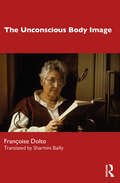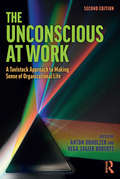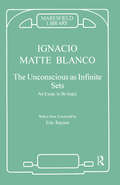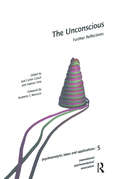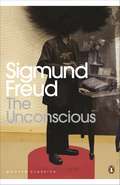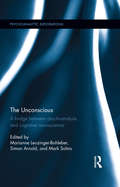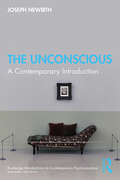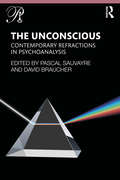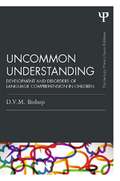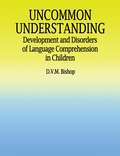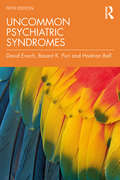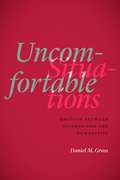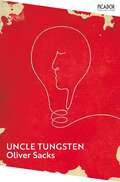- Table View
- List View
The Unconscious Body Image
by Françoise DoltoThe Unconscious Body Image espouses a completely original view of the links between physical and psychic development, providing fresh insight into our understanding of psychosomatic symptoms and child development. Françoise Dolto describes how unconsciously held mental images of the body and its functioning impact upon the subject’s feelings and ideas of themself, and conversely how emotions and ideas impact upon the body’s functioning by way of these unconscious images. The Unconscious Body Image also presents Dolto’s view of the development of mind in relation to unconscious body images generated at each stage of development (oral, anal, genital, latency and puberty), and ideas about psychic castration at each developmental stage and children’s socialisation, filling a significant gap in psychoanalytic understanding of the mental integration of social law. This book will be a key text for psychoanalysts in practice and in training, particularly those working with children, psychoanalytic psychotherapists and psychodynamic practitioners in the social sciences, childcare and education.
The Unconscious at Work: A Tavistock Approach to Making Sense of Organizational Life
by Anton Obholzer Vega Zagier RobertsWhy do our organizations so often seem to be less than the sum of their parts? What undermines effectiveness and morale, and gets in the way of achieving what we set out to do? The Unconscious at Work, Second Edition draws on a body of thinking and practice which has developed over the past 70 years, often referred to as 'the Tavistock approach' or 'systems-psychodynamics'. All the contributors are practising consultants who draw on this framework, bringing it alive and making it useful to any reader – manager, leader or consultant, regardless of whether they have any prior familiarity with the underlying concepts – who is curious about what might be driving the puzzling or stressful situations they find in their workplace. The First Edition was addressed to people working in 'the human services': health, social care and education. Since it was published in 1994, there has been growing interest in the business world, and in understanding more about the 'irrational' side of organizational life. Therefore, this Second Edition includes an entirely new section where the key ideas are revisited and illustrated with case studies from a wide range of business organizations, from large corporations to start-ups and family businesses. The aim, however remains the same: to enlarge readers' existing sense-making 'tool-kits' so that they can look at themselves and their organizations with fresh eyes, deepening the emotional intelligence they bring to bear on the challenges they face and providing new possibilities for action. The Unconscious at Work, Second Edition is for managers, leaders, consultants, and anyone working in organizations who has been puzzled, disturbed or challenged by their experiences at work.
The Unconscious at Work: A Tavistock Approach to Making Sense of Organizational Life
by Anton Obholzer Vega Zagier RobertsWhy do our organizations so often seem to be less than the sum of their parts? What undermines effectiveness and morale, and gets in the way of achieving what we set out to do? The Unconscious at Work, Second Edition draws on a body of thinking and practice which has developed over the past 70 years, often referred to as 'the Tavistock approach' or 'systems-psychodynamics'. All the contributors are practising consultants who draw on this framework, bringing it alive and making it useful to any reader – manager, leader or consultant, regardless of whether they have any prior familiarity with the underlying concepts – who is curious about what might be driving the puzzling or stressful situations they find in their workplace. The First Edition was addressed to people working in 'the human services': health, social care and education. Since it was published in 1994, there has been growing interest in the business world, and in understanding more about the 'irrational' side of organizational life. Therefore, this Second Edition includes an entirely new section where the key ideas are revisited and illustrated with case studies from a wide range of business organizations, from large corporations to start-ups and family businesses. The aim, however remains the same: to enlarge readers' existing sense-making 'tool-kits' so that they can look at themselves and their organizations with fresh eyes, deepening the emotional intelligence they bring to bear on the challenges they face and providing new possibilities for action. The Unconscious at Work, Second Edition is for managers, leaders, consultants, and anyone working in organizations who has been puzzled, disturbed or challenged by their experiences at work.
The Unconscious as Infinite Sets: An Essay in Bi-logic
by Ignacio Matte BlancoA systematic effort to rethink Freud's theory of the unconscious, aiming to separate out the different forms of unconsciousness. The logico-mathematical treatment of the subject is made easy because every concept used is simple and simply explained from first principles. Each renewed explanation of the facts brings the emergence of new knowledge from old material of truly great importance to the clinician and the theorist alike. A highly original book that ought to be read by everyone interested in psychiatry or in Freudian psychology.
The Unconscious as Infinite Sets: An Essay in Bi-logic
by Ignacio Matte BlancoA systematic effort to rethink Freud's theory of the unconscious, aiming to separate out the different forms of unconsciousness. The logico-mathematical treatment of the subject is made easy because every concept used is simple and simply explained from first principles. Each renewed explanation of the facts brings the emergence of new knowledge from old material of truly great importance to the clinician and the theorist alike. A highly original book that ought to be read by everyone interested in psychiatry or in Freudian psychology.
The Unconscious: Further Reflections (The International Psychoanalytical Association Psychoanalytic Ideas and Applications Series)
by Jose C. CalichThis book provides contemporary perspectives concerning Freud's fundamental assumptions on the unconscious. It presents some of the original theoretical developments and the cogitations on the unconscious, from various world regions and different thought orientations.
The Unconscious: Further Reflections (The International Psychoanalytical Association Psychoanalytic Ideas and Applications Series)
by Jose C. CalichThis book provides contemporary perspectives concerning Freud's fundamental assumptions on the unconscious. It presents some of the original theoretical developments and the cogitations on the unconscious, from various world regions and different thought orientations.
The Unconscious: The Psychology Of Art, Literature, Love, And Religion (Penguin Modern Classics)
by Sigmund FreudOne of Freud's central achievements was to demonstrate how unacceptable thoughts and feelings are repressed into the unconscious, from where they continue to exert a decisive influence over our lives.This volume contains a key statement about evidence for the unconscious, and how it works, as well as major essays on all the fundamentals of mental functioning. Freud explores how we are torn between the pleasure principle and the reality principle, how we often find ways both to express and to deny what we most fear, and why certain men need fetishes for their sexual satisfaction. His study of our most basic drives, and how they are transformed, brilliantly illuminates the nature of sadism, masochism, exhibitionism and voyeurism.
The Unconscious: A bridge between psychoanalysis and cognitive neuroscience (Psychoanalytic Explorations)
by Marianne Leuzinger-Bohleber Simon Arnold Mark SolmsThe Unconscious explores the critical interdisciplinary dialogue between psychoanalysis and contemporary cognitive neuroscience. Characterised by Freud as ‘the science of the unconscious mind’, psychoanalysis has traditionally been viewed as a solely psychological discipline. However recent developments in neuroscience, such as the use of neuroimaging techniques to investigate the working brain, have stimulated and intensified the dialogue between psychoanalysis and these related mental sciences. This book explores the relevance of these discussions for our understanding of unconscious mental processes. Chapters present clinical case studies of unconscious dynamics, alongside theoretical and scientific papers in key areas of current debate and development. These include discussions of the differences between conceptualisations of ‘the unconscious’ in psychoanalysis and cognitive science, whether the core concepts of psychoanalysis are still plausible in light of recent findings, and how such understandings of the unconscious are still relevant to treating patients in psychotherapy today. These questions are explored by leading interdisciplinary researchers as well as practising psychoanalysts and psychotherapists. This book aims to bridge the gap between psychoanalysis and cognitive neuroscience, to enable a better understanding of researchers’ and clinicians’ engagements with the key topic of the unconscious. It will be of key interest to researchers, academics and postgraduate students in the fields of psychoanalysis, cognitive science, neuroscience and traumatology. It will also appeal to practising psychoanalysts, psychotherapists and clinicians.
The Unconscious: A bridge between psychoanalysis and cognitive neuroscience (Psychoanalytic Explorations)
by Marianne Leuzinger-Bohleber Simon Arnold Mark SolmsThe Unconscious explores the critical interdisciplinary dialogue between psychoanalysis and contemporary cognitive neuroscience. Characterised by Freud as ‘the science of the unconscious mind’, psychoanalysis has traditionally been viewed as a solely psychological discipline. However recent developments in neuroscience, such as the use of neuroimaging techniques to investigate the working brain, have stimulated and intensified the dialogue between psychoanalysis and these related mental sciences. This book explores the relevance of these discussions for our understanding of unconscious mental processes. Chapters present clinical case studies of unconscious dynamics, alongside theoretical and scientific papers in key areas of current debate and development. These include discussions of the differences between conceptualisations of ‘the unconscious’ in psychoanalysis and cognitive science, whether the core concepts of psychoanalysis are still plausible in light of recent findings, and how such understandings of the unconscious are still relevant to treating patients in psychotherapy today. These questions are explored by leading interdisciplinary researchers as well as practising psychoanalysts and psychotherapists. This book aims to bridge the gap between psychoanalysis and cognitive neuroscience, to enable a better understanding of researchers’ and clinicians’ engagements with the key topic of the unconscious. It will be of key interest to researchers, academics and postgraduate students in the fields of psychoanalysis, cognitive science, neuroscience and traumatology. It will also appeal to practising psychoanalysts, psychotherapists and clinicians.
The Unconscious: A Contemporary Introduction (Routledge Introductions to Contemporary Psychoanalysis)
by Joseph NewirthIn The Unconscious: A Contemporary Introduction, Joseph Newirth presents a critical and comparative analysis of the unconscious and its evolution from a positivist to a postmodern frame of reference. This book presents five theories, each of which offers different and important conceptualizations of the unconscious, and each of which contains a rich palate of ideas through which to approach clinical work. These psychoanalytic theories are thought of as spokes on a wheel emanating from the center of Freud’s concept of the unconscious. In addition to presenting Freud’s development of the unconscious, Newirth includes discussions of interpersonal/relational psychoanalysis; developmental approaches to the unconscious, including Kohut, Winnicott, and Fonagy; Kleinian approaches to the unconscious; and linguistic theories of the unconscious including Matte Blanco and Lacan. The last chapter illustrates the use of contemporary psychoanalytic concepts in the clinical work with a contemporary patient. The book encourages a comparative view of psychoanalytic theory and technique and aims to move to a more useful, generalizable concept of the unconscious for the contemporary patient. This book will be of great interest to psychoanalysts, psychologists, and anyone interested in the evolution and application of the unconscious as a concept.
The Unconscious: A Contemporary Introduction (Routledge Introductions to Contemporary Psychoanalysis)
by Joseph NewirthIn The Unconscious: A Contemporary Introduction, Joseph Newirth presents a critical and comparative analysis of the unconscious and its evolution from a positivist to a postmodern frame of reference. This book presents five theories, each of which offers different and important conceptualizations of the unconscious, and each of which contains a rich palate of ideas through which to approach clinical work. These psychoanalytic theories are thought of as spokes on a wheel emanating from the center of Freud’s concept of the unconscious. In addition to presenting Freud’s development of the unconscious, Newirth includes discussions of interpersonal/relational psychoanalysis; developmental approaches to the unconscious, including Kohut, Winnicott, and Fonagy; Kleinian approaches to the unconscious; and linguistic theories of the unconscious including Matte Blanco and Lacan. The last chapter illustrates the use of contemporary psychoanalytic concepts in the clinical work with a contemporary patient. The book encourages a comparative view of psychoanalytic theory and technique and aims to move to a more useful, generalizable concept of the unconscious for the contemporary patient. This book will be of great interest to psychoanalysts, psychologists, and anyone interested in the evolution and application of the unconscious as a concept.
The Unconscious: Contemporary Refractions In Psychoanalysis (Psychoanalysis in a New Key Book Series)
by Pascal Sauvayre David BraucherThis book explores the unconscious in psychoanalysisusing cross-disciplinary input from the cultural, social and linguistic perspectives. This book is the first contemporary collection applying the various perspectives from within the psychoanalytic discipline. It covers the unconscious from three main perspectives: the metaphysical, including links with quantum mechanics and Jung's thought; the socio-relational, drawing on ideas from politics, inter-generational trauma and the interpersonal; and the linguistic, drawing on notions of the social construct of language and hermeneutics. Throughout the history of psychoanalysis, theorists have wrestled with the ubiquitousness and diverse nature of the unconscious. This collection is an account of the contemporary psychoanalytic struggle to understand and work with this quintessential, defining, and foundational object of psychoanalysis. This book is primarily of interest to practicing clinicians and trainees. It is also of significant interest to any academic professionals and students who adapt psychoanalytic thought in their studies in the humanities, including literature, philosophy, and the social sciences.
The Unconscious: Contemporary Refractions In Psychoanalysis (Psychoanalysis in a New Key Book Series)
by Pascal Sauvayre David BraucherThis book explores the unconscious in psychoanalysisusing cross-disciplinary input from the cultural, social and linguistic perspectives. This book is the first contemporary collection applying the various perspectives from within the psychoanalytic discipline. It covers the unconscious from three main perspectives: the metaphysical, including links with quantum mechanics and Jung's thought; the socio-relational, drawing on ideas from politics, inter-generational trauma and the interpersonal; and the linguistic, drawing on notions of the social construct of language and hermeneutics. Throughout the history of psychoanalysis, theorists have wrestled with the ubiquitousness and diverse nature of the unconscious. This collection is an account of the contemporary psychoanalytic struggle to understand and work with this quintessential, defining, and foundational object of psychoanalysis. This book is primarily of interest to practicing clinicians and trainees. It is also of significant interest to any academic professionals and students who adapt psychoanalytic thought in their studies in the humanities, including literature, philosophy, and the social sciences.
Uncommon Understanding: Development and disorders of language comprehension in children (Psychology Press & Routledge Classic Editions)
by Dorothy V. BishopThis is a Classic Edition of Dorothy Bishop's award-winning textbook on the development of language comprehension, which has been in print since 1997, and now includes a new introduction from the author. The book won the British Psychological Society book award in 1999, and is now widely seen as a classic in the field of developmental language disorders. Uncommon Understanding provides a comprehensive account of the process of comprehension, from the reception of an acoustic signal, to the interpretation of communicative intentions, and integrates a vast field of research on language acquisition, psycholinguistics and neuropsychology. In the new introduction Dorothy Bishop reflects on the organization of the book, and developments in the field since the book was first published. A major theme in the book is that comprehension should not be viewed as a unitary skill – to understand spoken language one needs the ability to classify incoming speech sounds, to relate them to a "mental lexicon," to interpret the propositions encoded by word order and grammatical inflections, and to use information from the environmental and social context to grasp an intended meaning. Another important theme is that although neuropsychological and experimental research on adult comprehension provides useful concepts and methods for assessing comprehension, it should be applied with caution, because a sequential, bottom-up information processing model of comprehension is ill-suited to the developmental context. Although the main focus of the book is on research and theory, rather than practical matters of assessment and intervention, the theoretical framework presented in the book will continue to help clinicians develop a clearer understanding of what comprehension involves, and how different types of difficulty may be pin-pointed.
Uncommon Understanding: Development and disorders of language comprehension in children (Psychology Press & Routledge Classic Editions)
by Dorothy V. BishopThis is a Classic Edition of Dorothy Bishop's award-winning textbook on the development of language comprehension, which has been in print since 1997, and now includes a new introduction from the author. The book won the British Psychological Society book award in 1999, and is now widely seen as a classic in the field of developmental language disorders. Uncommon Understanding provides a comprehensive account of the process of comprehension, from the reception of an acoustic signal, to the interpretation of communicative intentions, and integrates a vast field of research on language acquisition, psycholinguistics and neuropsychology. In the new introduction Dorothy Bishop reflects on the organization of the book, and developments in the field since the book was first published. A major theme in the book is that comprehension should not be viewed as a unitary skill – to understand spoken language one needs the ability to classify incoming speech sounds, to relate them to a "mental lexicon," to interpret the propositions encoded by word order and grammatical inflections, and to use information from the environmental and social context to grasp an intended meaning. Another important theme is that although neuropsychological and experimental research on adult comprehension provides useful concepts and methods for assessing comprehension, it should be applied with caution, because a sequential, bottom-up information processing model of comprehension is ill-suited to the developmental context. Although the main focus of the book is on research and theory, rather than practical matters of assessment and intervention, the theoretical framework presented in the book will continue to help clinicians develop a clearer understanding of what comprehension involves, and how different types of difficulty may be pin-pointed.
Uncommon Understanding: Development and Disorders of Language Comprehension in Children
by Dorothy V.M. BishopA great deal has been written on how children learn to speak, but development of language comprehension has been a relatively neglected topic. This book is unique in integrating research in language acquisition, psycholinguistics and neuropsychology to give a comprehensive picture of the process we call "comprehension", right from the reception of an acoustic stimulus at the ear, up to the point where we interpret the message the speaker intended to convey by the utterance. A major theme of the book is that "comprehension" is not a unitary skill: to understand spoken language, one needs the ability to classify incoming speech sounds, to relate them to a "mental lexicon", to interpret the propositions encoded by word order and grammatical inflections, and to use information from the environmental and social context to select, from a wide range of possible interpretations, the one that was intended by the speaker. Furthermore, although neuropsychological and experimental research on adult comprehension can provide useful concepts and methods for assessing comprehension, they should be applied with caution, because a sequential, bottom-up information processing model of comprehension is ill-suited to the developmental context.The emphasis of the book is on children with specific language impairments, but normal development is also given extensive coverage. The focus is on research and theory, rather than practical matters of assessment and intervention. Nevertheless, while this book is not intended as a clinical guide to assessment, it does aim to provide a theoretical framework that can help clinicians develop a clearer understanding of what comprehension involves, and how different types of difficulty may be pinpointed.
Uncommon Understanding: Development and Disorders of Language Comprehension in Children
by Dorothy V.M. BishopA great deal has been written on how children learn to speak, but development of language comprehension has been a relatively neglected topic. This book is unique in integrating research in language acquisition, psycholinguistics and neuropsychology to give a comprehensive picture of the process we call "comprehension", right from the reception of an acoustic stimulus at the ear, up to the point where we interpret the message the speaker intended to convey by the utterance. A major theme of the book is that "comprehension" is not a unitary skill: to understand spoken language, one needs the ability to classify incoming speech sounds, to relate them to a "mental lexicon", to interpret the propositions encoded by word order and grammatical inflections, and to use information from the environmental and social context to select, from a wide range of possible interpretations, the one that was intended by the speaker. Furthermore, although neuropsychological and experimental research on adult comprehension can provide useful concepts and methods for assessing comprehension, they should be applied with caution, because a sequential, bottom-up information processing model of comprehension is ill-suited to the developmental context.The emphasis of the book is on children with specific language impairments, but normal development is also given extensive coverage. The focus is on research and theory, rather than practical matters of assessment and intervention. Nevertheless, while this book is not intended as a clinical guide to assessment, it does aim to provide a theoretical framework that can help clinicians develop a clearer understanding of what comprehension involves, and how different types of difficulty may be pinpointed.
Uncommon Psychiatric Syndromes (A\hodder Arnold Publication)
by David Enoch Basant K. Puri Hadrian BallThis book explores the historical background to, and present-day understanding of, a number of unusual psychiatric disorders. This fully revised new edition contains a new chapter on a range of recently emerging conditions as well as updated literature and a collection of new and updated cases. Since the publication of the fourth edition, there have been many developments in the field of psychiatry, including changes in the Diagnostic and Statistical Manual of Mental Disorders (DSM-5) and the advancement of neuroimaging and related research, which have been incorporated into the fifth edition. In this now classic text, each chapter covers an individual disorder in detail, using several case studies gathered by the authors themselves to illustrate and exemplify the disorders discussed. The clear and easy-to-understand writing style ensures that this text is accessible for the wide range of studies and professions who will find it useful. Uncommon Psychiatric Syndromes, Fifth Edition, is essential reading for psychiatrists, clinical psychologists, psychiatric nurses, psychiatric social workers, social workers and other mental health professionals. It will also be of interest to graduate students in the fields of psychiatry and psychology as well as those enrolled in psychiatry resident courses.
Uncommon Psychiatric Syndromes
by David Enoch Basant K. Puri Hadrian BallThis book explores the historical background to, and present-day understanding of, a number of unusual psychiatric disorders. This fully revised new edition contains a new chapter on a range of recently emerging conditions as well as updated literature and a collection of new and updated cases. Since the publication of the fourth edition, there have been many developments in the field of psychiatry, including changes in the Diagnostic and Statistical Manual of Mental Disorders (DSM-5) and the advancement of neuroimaging and related research, which have been incorporated into the fifth edition. In this now classic text, each chapter covers an individual disorder in detail, using several case studies gathered by the authors themselves to illustrate and exemplify the disorders discussed. The clear and easy-to-understand writing style ensures that this text is accessible for the wide range of studies and professions who will find it useful. Uncommon Psychiatric Syndromes, Fifth Edition, is essential reading for psychiatrists, clinical psychologists, psychiatric nurses, psychiatric social workers, social workers and other mental health professionals. It will also be of interest to graduate students in the fields of psychiatry and psychology as well as those enrolled in psychiatry resident courses.
Uncomfortable Situations: Emotion between Science and the Humanities
by Daniel M. GrossWhat is a hostile environment? How exactly can feelings be mixed? What on earth might it mean when someone writes that he was “happily situated” as a slave? The answers, of course, depend upon whom you ask. Science and the humanities typically offer two different paradigms for thinking about emotion—the first rooted in brain and biology, the second in a social world. With rhetoric as a field guide, Uncomfortable Situations establishes common ground between these two paradigms, focusing on a theory of situated emotion. Daniel M. Gross anchors the argument in Charles Darwin, whose work on emotion has been misunderstood across the disciplines as it has been shoehorned into the perceived science-humanities divide. Then Gross turns to sentimental literature as the single best domain for studying emotional situations. There’s lost composure (Sterne), bearing up (Equiano), environmental hostility (Radcliffe), and feeling mixed (Austen). Rounding out the book, an epilogue written with ecological neuroscientist Stephanie Preston provides a different kind of cross-disciplinary collaboration. Uncomfortable Situations is a conciliatory work across science and the humanities—a groundbreaking model for future studies.
Uncomfortable Situations: Emotion between Science and the Humanities
by Daniel M. GrossWhat is a hostile environment? How exactly can feelings be mixed? What on earth might it mean when someone writes that he was “happily situated” as a slave? The answers, of course, depend upon whom you ask. Science and the humanities typically offer two different paradigms for thinking about emotion—the first rooted in brain and biology, the second in a social world. With rhetoric as a field guide, Uncomfortable Situations establishes common ground between these two paradigms, focusing on a theory of situated emotion. Daniel M. Gross anchors the argument in Charles Darwin, whose work on emotion has been misunderstood across the disciplines as it has been shoehorned into the perceived science-humanities divide. Then Gross turns to sentimental literature as the single best domain for studying emotional situations. There’s lost composure (Sterne), bearing up (Equiano), environmental hostility (Radcliffe), and feeling mixed (Austen). Rounding out the book, an epilogue written with ecological neuroscientist Stephanie Preston provides a different kind of cross-disciplinary collaboration. Uncomfortable Situations is a conciliatory work across science and the humanities—a groundbreaking model for future studies.
Uncomfortable Situations: Emotion between Science and the Humanities
by Daniel M. GrossWhat is a hostile environment? How exactly can feelings be mixed? What on earth might it mean when someone writes that he was “happily situated” as a slave? The answers, of course, depend upon whom you ask. Science and the humanities typically offer two different paradigms for thinking about emotion—the first rooted in brain and biology, the second in a social world. With rhetoric as a field guide, Uncomfortable Situations establishes common ground between these two paradigms, focusing on a theory of situated emotion. Daniel M. Gross anchors the argument in Charles Darwin, whose work on emotion has been misunderstood across the disciplines as it has been shoehorned into the perceived science-humanities divide. Then Gross turns to sentimental literature as the single best domain for studying emotional situations. There’s lost composure (Sterne), bearing up (Equiano), environmental hostility (Radcliffe), and feeling mixed (Austen). Rounding out the book, an epilogue written with ecological neuroscientist Stephanie Preston provides a different kind of cross-disciplinary collaboration. Uncomfortable Situations is a conciliatory work across science and the humanities—a groundbreaking model for future studies.
Uncomfortable Situations: Emotion between Science and the Humanities
by Daniel M. GrossWhat is a hostile environment? How exactly can feelings be mixed? What on earth might it mean when someone writes that he was “happily situated” as a slave? The answers, of course, depend upon whom you ask. Science and the humanities typically offer two different paradigms for thinking about emotion—the first rooted in brain and biology, the second in a social world. With rhetoric as a field guide, Uncomfortable Situations establishes common ground between these two paradigms, focusing on a theory of situated emotion. Daniel M. Gross anchors the argument in Charles Darwin, whose work on emotion has been misunderstood across the disciplines as it has been shoehorned into the perceived science-humanities divide. Then Gross turns to sentimental literature as the single best domain for studying emotional situations. There’s lost composure (Sterne), bearing up (Equiano), environmental hostility (Radcliffe), and feeling mixed (Austen). Rounding out the book, an epilogue written with ecological neuroscientist Stephanie Preston provides a different kind of cross-disciplinary collaboration. Uncomfortable Situations is a conciliatory work across science and the humanities—a groundbreaking model for future studies.
Uncle Tungsten: Memories of a Chemical Boyhood (Picador Collection)
by Oliver Sacks‘If you did not think that gallium and iridium could move you, this superb book will change your mind’ The Times In Uncle Tungsten, Oliver Sacks evokes, with warmth and wit, his upbringing in wartime England. He tells of the large science-steeped family who fostered his early fascination with chemistry. There follow his years at boarding school where, though unhappy, he developed the intellectual curiosity that would shape his later life. And we hear of his return to London, an emotionally bereft ten-year-old who found solace in his passion for learning. Uncle Tungsten radiates all the delight and wonder of a boy’s adventures, and is an unforgettable portrait of an extraordinary young mind.
